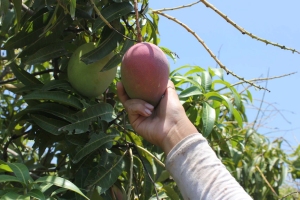 Mango farming is an economically viable venture in tropical and sub-tropical parts of the world. With improved harvesting, handling, and shipping procedures, the fruit has gained global popularity and created numerous jobs in the process. In Australia, the mango harvesting season starts in the month of October in Western Australia and November in Northern Australia and Queensland.
Mango farming is an economically viable venture in tropical and sub-tropical parts of the world. With improved harvesting, handling, and shipping procedures, the fruit has gained global popularity and created numerous jobs in the process. In Australia, the mango harvesting season starts in the month of October in Western Australia and November in Northern Australia and Queensland.
Mango harvesting jobs are typically available during this period. The harvesting season basically runs for four to six weeks. This period can last up to three months on some farms but all the tasks are completed by the end of February.
Nature Of Mango Harvesting Jobs
Mango harvesting is not as simple as it sounds. Mango harvesting jobs involve doing repetitive tasks for long working hours in a hot environment where temperatures average 30°C. The job is physically demanding and lacking in intellectual stimulation and excitement.
Mango pickers use ladders to reach the fruits that are perched up high on the trees. Mango harvesting jobs also involve lifting and carrying baskets. There are farms that harvest fruits by hand, others use poles that take time to master. If you don’t like hard work, you may opt to work in the packing sheds where sorting of mangoes is done.
Most farms have a wide range of mango harvesting jobs available during the harvesting season. The most common jobs include:
• Packers
• Labelers
• Graders
• Pallet Controllers
• Stackers
• Dispatch Operators
• Harvest Drivers
• Bin Runners
• Forklift Operators
• Water Girls or Boys
• Water Truck Drivers
Basic Requirements for Mango Harvesting Jobs
To take up any mango harvesting job, you’ll have to exhibit a good work ethic. You should also not be color blind, have sensitive skin, or be suffering from mango allergies. Further, you should be physically fit and capable of working long hours in an outdoor environment either picking mangoes, grading them, packing, or stacking them up in the sheds.
It’s important that you be prepared to work throughout the harvesting period – farmers prefer to hire workers that can commit availability throughout the harvesting season.
To go through the mango harvesting season successfully, farmers must put together positive, self-driven teams. Ideally, such teams should consist of workers that understand the importance of maintaining their safety and that of their colleagues at all times.
Workers who have previous experience in citrus or mango harvesting tend to be prioritized in the hiring process. Other workers that are considered include workers that have forklifts and truck licenses.
In addition to the requirements listed above, here’s a list of other things that Australian mango farmers use when hiring workers to help with mango harvesting:
• Ability to work flexible shifts
• Ability to communicate well in English
• Drugs and alcohol-free – potential workers must pass an alcohol and drug test
• Have a front-end loader and heavy rigid truck license
• Have a driver’s license
• Enjoy working in a busy environment
Dressing for Mango Harvesting Jobs
Since mango harvesting jobs are done in open fields and under hot weather conditions, workers are strongly encouraged to remain cool and hydrated at all times. When dressing for the job, mango harvests should:
• Wear sturdy, non-slip footwear
• Be in shorts or long pants
• Wear long-sleeved shirts
• Protect their skin with sunscreen
• Have a broad-brimmed hat to cover the head
How To Pick Mangoes
If you get a job as a mango picker, you’ll be clipping the fruit from the tree in a mature, but an unripe condition. Only mature mangoes get picked, the rest are left on the tree to grow to maturity. The main thing that shows mangoes are ready for picking is the background color. Mature mangoes turn from a bright green color to a dull green-yellowish color. Often, this happens three to five months after the mango trees flower, depending on weather conditions and the variety planted.
The maturity of mangoes is also indicated by the filling of the fruit shoulders and nose or beak. The nose refers to the end of the fruit that’s opposite the stem. The inner part of the fruit changes from white to yellow when the mango is mature. Mango pickers are often advised to maintain a four to five-centimeter stem on the fruit during harvesting to keep the sap from spurting and causing sap burn that damages the fruit or itchiness to the skin.
Pay for Mango Harvesting Jobs
In Australia, mango harvesting workers are either paid per piece or per hour. If you negotiate for a pay-per-piece package, your earnings will be determined by the number of mangoes you pick. Ideally, the more mangoes you harvest, the more you’ll earn. As you learn and perfect the picking technique, you’ll be able to increase your daily picks. Generally, hourly rates range between $16 and $20 per hour in Australia. However, the per piece rate varies from farm to farm. Workers who work in mango packing sheds are paid using the hourly rate.
Shift Frequency © 2021 – Brief Guide on
Mango Harvesting and Jobs
